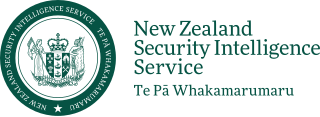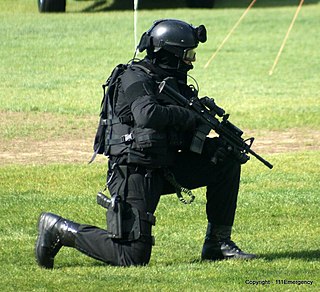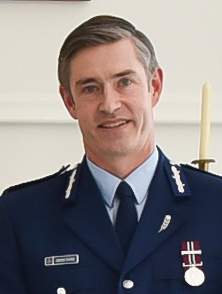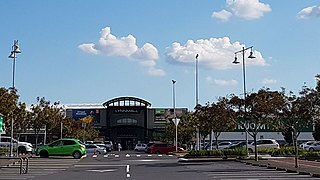| Special Tactics Group | |
|---|---|
| Active |
|
| Country | New Zealand |
| Agency | New Zealand Police |
| Type | Police tactical group |
| Role | |
| Headquarters | Wellington |
| Abbreviation | STG |
| Structure | |
| Operators | 39 [1] |
| Sections | |
| Notables | |
| Significant operation(s) | |
The Special Tactics Group (STG) is the full-time police tactical group of the New Zealand Police. The STG, originally named the Anti-Terrorist Squad (ATS), was established to respond to high-risk situations which are beyond the scope or capacity of everyday policing. STG officers directly support operational police in incidents, such as sieges, with specialist tactical, negotiation, intelligence, and command support services.
Officers are assigned to the STG on a full-time basis with sections based in Auckland, Wellington and Christchurch. [2] In 2012, the STG became a police tactical group following the New Zealand government joining Australia’s national counter-terrorism coordination organisation. [3]
In 1977, the New Zealand Police formed the Anti-Terrorist Squad (ATS) a part-time national unit to respond to terrorist incidents. [4] [5] Training commenced in July 1977 for selected members of the Armed Offenders Squad (AOS). A section of the ATS was based in Wellington with smaller sections based in Auckland and Christchurch. [6] Commissioner of Police John Jamieson sent the group in response to the Aramoana massacre in 1990. [7] They located gunman David Gray and ended his spree. Group member Stephen Vaughan was shot in the ankle during the final shoot-out.
In 1991, the ATS was renamed the Special Tactics Group. [8] [9] [10] The STG was tasked with additional roles. [11] On 1 July 2003, the STG became a full-time group due to changes made by the New Zealand Police in response to worldwide terrorism-related events. [12] [13] [4] In May 2009, the STG was involved in the Napier shootings alongside their colleagues in the Armed Offenders Squad. [10] In March 2019, the STG responded to a terrorist attack at two mosques in Christchurch providing specialist first aid to the victims. [14] [15] The STG was coincidentally at a sniping course with international police at Burnham Military Camp in Christchurch and armed operators from Australian police tactical groups also responded to the attack at the Al Noor mosque. [15] [16] In September 2021, two STG operators fatally shot a "ISIS-inspired" terrorist following a stabbing attack at a Countdown supermarket in Auckland. [17] [18]
The STG deals with armed incidents that are beyond the capability of the part-time Armed Offenders Squad, of which they are also members. While the Armed Offenders Squad is trained to cordon or contain high risk situations such as sieges, the Special Tactics Group is trained to resolve them. [19] The group also provides specialist protection to high risk persons and VIPs. [20] The STG is supported during its operations by the Armed Offenders Squad, Police Negotiation Teams and canine units trained for use in situations involving firearms.
The group is known to train with New Zealand Special Air Service of which little public information is released as well as with Australian police tactical groups. [21] [22] [12] [23]
The STG has provided specialist armed officers for overseas operations such as the Regional Assistance Mission to the Solomon Islands (RAMSI), working alongside officers from the Australian Federal Police. [10] The STG has deployed to Australia to assist Australian police tactical groups with security at major events including the 2007 APEC meeting in Sydney and the 2014 G20 summit in Brisbane. [24] [4] STG have been part of all major security operations in New Zealand including the 1990 Commonwealth Games, the Commonwealth Heads of Government Meeting 1995, APEC meetings, royal and VIP tours. [20] In 2012, the New Zealand Government entered into Australia's National Counter-Terrorism arrangement forming a co-operation partnership between the countries with the committee that oversees the agreement renamed to the Australia-New Zealand Counter-Terrorism Committee. [3]
The STG works closely with No. 3 Squadron of the Royal New Zealand Air Force utilising their NH-90 helicopters for both training and operations including with fast roping. [25] [26] [27] The New Zealand Police Air Support Unit also provides the STG with support with their Bell 429 GlobalRanger helicopters. [28] [25]
The STG also provides specialist assistance in performing tasks that are beyond the scope of operational police. Some of these tasks may require specialist equipment or expertise in certain areas.
In 2017–18, the STG "were deployed 84 times". [4]
Positions are open to current or past members of the Armed Offenders Squad. Officers must successfully complete the STG four-day selection course and three-week qualification course to gain selection to the unit. [2] In 2007, the first woman passed the selection course. [29]
In keeping with the weapons available to front-line officers, the STG are issued with the following equipment:
For deployment of CS gas, the Remington 870 shotgun and HK69 grenade launcher can be used while the shotgun may also apply for breaching purposes. In 2013, the STG was issued with non-lethal 40mm XM1006 sponge rounds that are fired from the HK69 grenade launcher. [31]
When responding to incidents, or executing planned operations, AOS officers utilise both standard marked and unmarked cars, and large four-wheel drive vehicles, such as the Nissan Patrol. These are fitted with running boards and roof rails, to allow officers to stand on the side while the vehicle is in motion, as well as having enclosed boxes on the roof for carrying equipment. [32]
In 2009, two New Zealand Army LAV III light armour vehicles were utilised in response to the Napier shootings. The STG has since conducted training exercises with the LAV III. [22] In 2019, the STG took delivery of three ASC armoured Toyota Land Cruisers. [33] [34]

The New Zealand Police is the national police service and principal law enforcement agency of New Zealand, responsible for preventing crime, enhancing public safety, bringing offenders to justice, and maintaining public order. With about 13,000 personnel, it is the largest law enforcement agency in New Zealand and, with few exceptions, has primary jurisdiction over the majority of New Zealand criminal law. The New Zealand Police also has responsibility for traffic and commercial vehicle enforcement as well as other key responsibilities including protection of dignitaries, firearms licensing, and matters of national security.

The New Zealand Security Intelligence Service is New Zealand's primary national intelligence agency. It is responsible for providing information and advising on matters including national security and foreign intelligence. It is headquartered in Wellington and overseen by a Director-General, the Minister of New Zealand Security Intelligence Service, and the parliamentary intelligence and security committee; independent oversight is provided by the Inspector-General of Intelligence and Security.

Goodbye Pork Pie is a 1981 New Zealand comedy film directed by Geoff Murphy, co-produced by Murphy and Nigel Hutchinson, and written by Geoff Murphy and Ian Mune. The film was New Zealand's first large-scale local hit. One book described it as Easy Rider meets the Keystone Cops.

The Aramoana massacre was a mass shooting that occurred on 13 November 1990 in the small seaside township of Aramoana, northeast of Dunedin, New Zealand. Resident David Gray killed 13 people, including local police Sergeant Stewart Guthrie, one of the first responders to the reports of a shooting, after a verbal dispute between Gray and his next-door neighbour. After a careful house-to-house search the next day, police officers led by the Anti-Terrorist Squad located Gray, and shot and injured him as he came out of a house firing from the hip. He died in an ambulance while being transported to hospital.

The Armed Offenders Squad (AOS) are specialist part-time units of the New Zealand Police based around the country available to respond to high risk incidents using specialist tactics and equipment.
The Mongrel Mob is an organised street gang and prison gang based in New Zealand. With a network of more than thirty chapters throughout the country and additional operations in Australia and Canada, the Mob is the largest gang in New Zealand. They are especially active in the King Country, Kawerau, Ōpōtiki, Waikato and Hastings. The Mongrel Mob's main rival is the Black Power gang; there have been several very public and violent clashes between the two gangs over the years.

Special Tasks and Rescue Group is the Police Tactical Group of the South Australia Police.
The State Protection Group (SPG) is part of the Counter Terrorism & Special Tactics Command of the New South Wales Police Force and was established in 1991 to deal with extraordinary policing responses. The SPG directly supports police in high-risk incidents such as sieges with specialised tactical, negotiation, intelligence and command-support services. The unit also provides rescue and bomb disposal support, canine policing, and armoury services.
Until July 2012 the Specialist Response and Security Team (SRS) was a Police Tactical Group of the Australian Federal Police (AFP) having responsibility for tactical and specialist operations within the Australian Capital Territory. The Operational Response Group (ORG) had responsibility for AFP National and International tactical operations. In July 2012 the SRS was merged with the ORG to create the Specialist Response Group.
Police tactical group (PTG) is the generic term used to refer to highly trained Australian and New Zealand police tactical units that tactically manage and resolve high-risk incidents, including sieges, armed-offender situations and terrorist incidents.
New Zealand has experienced few terrorist incidents in its short history and the threat is generally regarded as very low. However, the Security Intelligence Service (SIS) has warned against complacency. This article serves as a list and compilation of past acts of terrorism, attempts of terrorism, and other such items pertaining to terrorist activities within New Zealand. Significant acts of terrorism include the bombing of the Rainbow Warrior in 1985, an act of state-sponsored terrorism by France, and the Christchurch mosque shootings in 2019, a far-right attack which resulted in 51 deaths and 40 injuries.

The 2007 New Zealand police raids were a series of armed police raids conducted on 15 and 16 October 2007, in response to alleged paramilitary training camps in the Urewera mountain range near the town of Ruatoki. About 300 police, including members of the Armed Offenders Squad and Special Tactics Group, were involved in the raids, which involved the execution of search warrants at various addresses throughout New Zealand, and the establishment of roadblocks at Ruatoki and Tāneatua. The police seized four guns and 230 rounds of ammunition and arrested eighteen people. According to police, the raids were a culmination of more than a year of surveillance that uncovered and monitored the training camps.
The National Security Investigations Team (NSIT), known as the Special Investigation Group (SIG) prior to 2016, is a New Zealand government group that focuses on threats to national security, formed in response to the September 11 attacks. It is part of the New Zealand Police, with four NSIT teams in regional centres around the country.
The Diplomatic Protection Service (DPS), sometimes referred to as the Diplomatic Protection Squad, is a branch of the New Zealand Police that provides personal security for both national and visiting diplomats and VIPs. National VIPs that receive constant protection are the prime minister and the governor-general, while ministers, members of Parliament, the judiciary and the leader of the Opposition receive protection as needed. Protection is provided both in New Zealand and abroad. Previous visiting VIPs afforded DPS protection have included Tiger Woods during the 2002 New Zealand Open, and FBI Director Robert Mueller. The DPS also patrols foreign embassies, consulates and high commissions.

Peter Brendon Marshall was the 31st New Zealand Commissioner of Police, serving from 4 April 2011 to 2 April 2014. He was previously Commissioner of the Royal Solomon Islands Police Force.

The Christchurch mosque shootings were two consecutive mass shootings on two mosques in Christchurch, New Zealand on 15 March 2019. They were committed by Brenton Tarrant who entered both mosques during Friday prayer, firstly at the Al Noor Mosque at 1:40 p.m. and later at the Linwood Islamic Centre at 1:52 p.m.

Andrew David Coster is the current Commissioner of the New Zealand Police. Having previously served as Acting Deputy Commissioner, he has served as the New Zealand Commissioner of Police since 3 April 2020.

On 3 September 2021 at 14:40 NZST, eight people were injured in a mass stabbing at the LynnMall Countdown supermarket in New Lynn, Auckland, New Zealand. The attacker, Ahamed Samsudeen, was being followed by police officers, who intervened during the attack and shot and killed him after he charged the officers. He was pronounced dead at the scene. The incident was treated as terrorism and was "ISIS-inspired" according to Prime Minister Jacinda Ardern. It was the second stabbing in less than four months to occur at a Countdown supermarket, the first being in Dunedin, and the first terrorist attack in New Zealand since the Christchurch mosque shootings in 2019.
The Christchurch Masjidain Attack Inquiry is a coronial inquiry by the Coronial Services of New Zealand into the Christchurch mosque shootings which occurred on 15 March 2019. The coronial inquiry was preceded by criminal proceedings and a Royal Commission of Inquiry. The scope stage of the Inquiry was held between 22 and 24 February 2022, which led Coroner Brigitte Windley to identify 12 issues to be examined. The first phase was held between 24 October and 14 December 2023. The first phase examined nine issues including the events of the 15 March, the Police, emergency services, and Christchurch Hospital's response to the attack, whether shooter Brenton Tarrant received help during the attack, and the final movements and circumstances of each of the 51 deceased's deaths, The second phase will examine the Police firearms licensing process, Tarrant's online radicalisation and future responses to violent extremism.